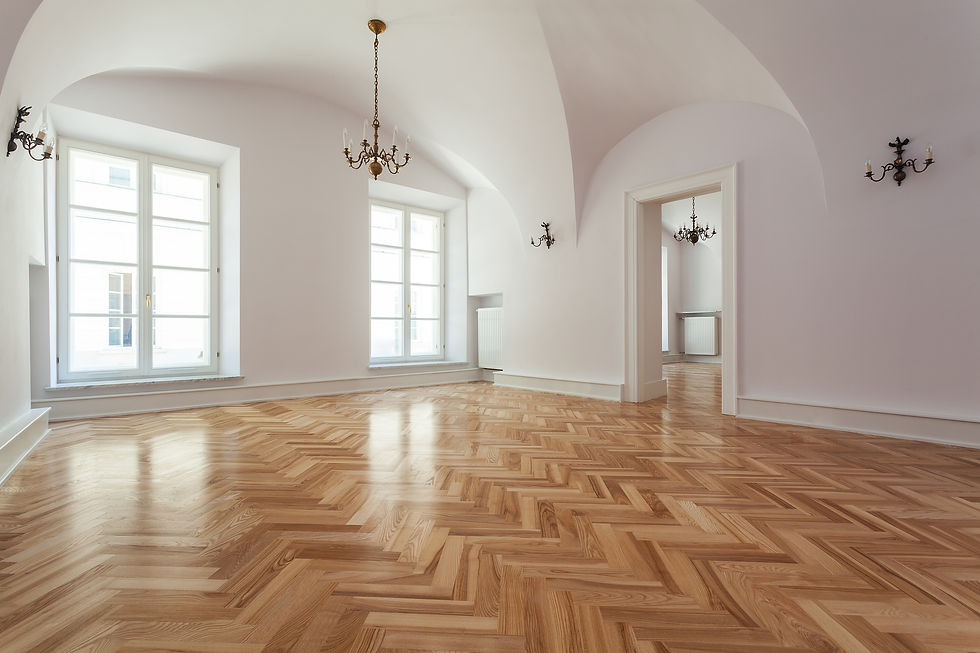How to Choose the Perfect Flooring Material for Your Home
- Jose Ferrareto
- Feb 18
- 4 min read
Choosing the right flooring for your home can feel overwhelming given the variety of options available today. From hardwood to tiles, vinyl to carpet, each material offers unique benefits and challenges. But don’t worry—making the right choice is easier than you think! By considering your home's style, functionality, and your lifestyle needs, you can confidently select a flooring material that’s both practical and beautiful. Here's a guide to help you choose the perfect flooring for your home.

1. Consider Your Lifestyle and Traffic
The first step in choosing flooring is to think about how you use each room. High-traffic areas like hallways and living rooms will need durable, easy-to-maintain materials. If you have young kids or pets, it’s essential to select flooring that can withstand wear and tear. For these spaces, consider options like ceramic or porcelain tiles, vinyl, or engineered hardwood.
For quieter, low-traffic areas such as bedrooms, you might want something cozy and warm like carpet or luxury vinyl planks. Consider how much maintenance you're willing to put in—hardwood may require occasional refinishing, while carpet will need regular vacuuming.
2. Think About the Aesthetic
The flooring you choose sets the tone for your home’s decor. Do you prefer a more traditional, rustic look? Or are you going for modern minimalism? Different materials offer different aesthetics:
Hardwood gives a timeless and classic look, ideal for traditional and contemporary spaces.
Laminate has improved significantly and can mimic the appearance of wood or stone at a fraction of the cost.
Tile (including stone, porcelain, or ceramic) is perfect for adding texture and a luxurious feel.
Carpet adds warmth and comfort, making it a great choice for bedrooms or cozy living rooms.
Think about the overall theme of your home and how the flooring material will enhance or complement it.
3. Assess Your Budget
Flooring costs can vary significantly based on the material and the installation process. For those on a tight budget, options like laminate, vinyl, or carpet provide great value without sacrificing quality. While hardwood and stone may be more expensive upfront, they can increase the resale value of your home, making them a good investment in the long run.
4. Factor in Durability and Maintenance
Durability is essential when it comes to selecting flooring that will last. Some materials are more resilient to damage, stains, and wear than others.
Hardwood and engineered wood are durable but require regular maintenance, including refinishing over time.
Vinyl and tile are incredibly durable, moisture-resistant, and easy to clean, making them ideal for kitchens and bathrooms.
Carpet, while cozy, can stain easily and wear down in high-traffic areas, but new options like stain-resistant carpets can make maintenance easier.
Concrete is becoming a more popular choice for modern homes, offering a sleek, industrial look with low maintenance needs.
5. Consider Moisture Levels
Certain rooms in your home, like the kitchen, bathroom, or basement, are exposed to higher moisture levels and require moisture-resistant flooring.
Ceramic and porcelain tile are perfect for wet areas because they won’t warp or stain with moisture.
Vinyl is another excellent option for moisture-prone areas and comes in a variety of styles and designs.
Engineered hardwood can be used in areas like the kitchen or basement but should be carefully sealed to prevent moisture damage.
Carpet is generally not suitable for bathrooms or kitchens, as it absorbs moisture and is prone to mold and mildew.
6. Energy Efficiency
Some flooring options can help improve your home’s energy efficiency. For instance, carpet is an excellent insulator and can help keep rooms warm. On the other hand, tile and wood flooring tend to be cooler and might require more heating in colder climates.
Incorporating an underlayment or using radiant floor heating can improve comfort no matter which flooring you choose.
7. Test Samples Before Committing
Once you’ve narrowed down your options, be sure to bring home a few samples. Seeing how they look in your space—under different lighting, with your existing furniture—will help you make a more informed decision. Additionally, walking on the sample helps you feel the texture and comfort level before installation.
8. Don’t Forget About Installation
The cost and complexity of installation vary depending on the flooring material. A lot of brands advertise products like vinyl planks and laminate as DIY-friendly but if you don't follow the right procedures and manufacturers guidelines you can lose your warranty and your DIY project can become a nightmare way costlier than hiring a professional installation. To ensure proper placement and longevity make sure you have a team of professionals, we are here to help.
Conclusion
Choosing the right flooring for your home is about balancing style, durability, budget, and practicality. Whether you’re renovating your living room, updating your kitchen, or outfitting a new build, understanding the pros and cons of each material can help guide your decision. Take your time, test your options, and choose the flooring that fits your lifestyle and vision for your home. Your floors will not only enhance the beauty of your space but also provide functionality for years to come!
For expert advice or help with flooring installation, contact us at Hardwood Pro Flooring. We're here to make your flooring dreams a reality!





Komentari